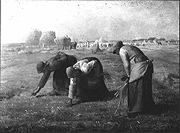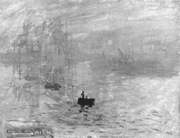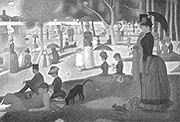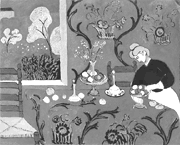| back to: Chapter 6 | The Modern World and Its Art |

The Gleaners Third Class Carriage Luncheon on the Grass Olympia The Bar at the Folies-Bergere |
REALISM-comes from direct observation of society and nature
Immanuel Kant-theorized the importance of the "disinterested viewer," that is the process of evaluating a work without sentiment based on the formal qualities of the piece. G.F.W. Hegel-saw art as a sort of "conscience" for the world and believed that it should exist on the perimeter of society to reflect and critque society. He said that the clash of contrary principles helps society progress. French Realist Painting -portrayed "proletariat" or working class or direct observation of nature The Barbizon School
Jean Baptiste Corot (1796-1875)
Jean-Francois Millet (1814-75)
The Gleaners- 1857, oil on canvas, 2'9"x 3'8"
Gustave Courbet (1819-77)
Honore Daumier (1808-79)
Rue Transonian, lithograph, c.1830's Third Class Carriage, 1862, oil on canvas
Edouard Manet
Dejeuner sur L'Herbe (Luncheon in the Grass), 1863, oil on canvas, 7'x 9'
Olympia, 1863, oil on canvas Bar at the Folies-Bergere, 1881-2, oil on canvas
|
 Impression: Sunrise The Little Dancer Fourteen Years Old |
IMPRESSIONISM-was interested in the effects of color
French Impressionism
Claude Monet
Impression: Sunrise, 1872, oil on canvas
Rouen Cathedral and Haystack series
Auguste Renoir Edgar Degas Absinthe, 1876, oil on canvas Little Dancer Fourteen Years Old, 1881, bronze sculpture |
 Sunday on the Island of La Grande Jatte The Starry Night |
POST-IMPRESSIONISM-was a movement based on Impressionism
Painting
Paul Cezanne
Mount Sainte Victoire series Georges Seurat
Sunday Afternoon on the Island of La Grande Jatte, 1884-6, oil on canvas
Vincent Van Gogh
The Night Cafe,
Starry Night, c. 1888-9, oil on canvas
Paul Gaugin
|
 The Red Room The Scream Les Demoiselles d'Avignon |
EARLY MODERNISM
Modernism was a movement that started around 1880 and ended in 1980. It was characterized by its theoretical approach to art. "Art for art's sake" was a term which exemplified this movement because it basically said that art should be examined further to find out more about itself. The Modernists worked on theories of color, spirituality, universality, psychology, perception and the idea behind the art sometimes became more important than the image produced. -worked from ideas in psychology like Faber Birren's Psychology of Color. Birren found that people reacted differently when exposed to different colors. For instance, red made people hungry; blue was a calming color; etc. Expressionism Edward Munch, The Scream, 1893, oil on canvas. the Fauves
Henri Matisse
Vassily Kandinsky
Cubism
Picasso
Les Demoiselles d'Avignon, 1907, oil on canvas, 8'x 7'8"
Three Musicians, 1921, oil on canvas, 6'7"x 7'3"
Guernica, 1937, oil on canvas, 11'6"x 25'6"
|
 Wainwright Building |
19th CENTURY ARCHITECTURE-Began with a new interest in materials
Sir Joseph Paxton, Crystal Palace, 1851, London World Exposition
Gustave Eiffel, Eiffel Tower, 1889, Paris World Exposition
Henry Hobson Richardson, Marshall Fields Store, 1885, Chicago
Louis Sullivan, Wainright Building, 1890, St. Louis
|
| Next study guide: Chapter 8 |

Custom Search
|